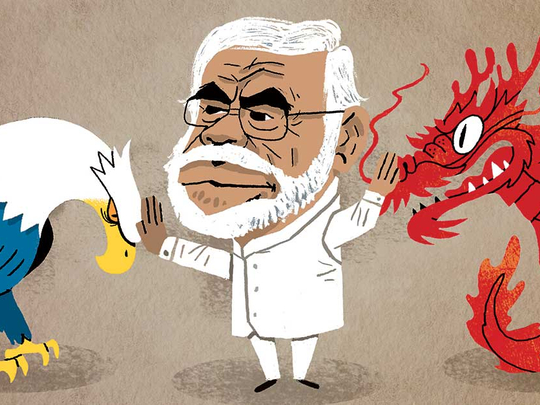
Barack Obama’s pivot to Asia has had a bad press. The moment the US president uttered the phrase, the Middle East demanded closer attention. The scepticism should ease with last week’s deal on a trans-Pacific trade and investment pact. There are hurdles still to jump, but the accord among a dozen Pacific Rim nations speaks to the power of geoeconomics.
There is also the view through the other end of the telescope. Washington is not the only party to the strategic realignment under way in Asia in response to China’s rise. Maybe we should be talking about Asia’s pivot to Washington.
I was reminded of this during a week-long study group in India organised by the European Council on Foreign Relations and Germany’s Robert Bosch Foundation. The purpose of a crammed agenda of meetings with politicians, policymakers and scholars was to find out ‘What India Thinks’.
For a bunch of Europeans, one answer was decidedly depressing. Indians may buy German engineering and French jets, but in the game of great power politics, Europe is a bit-part player. The serious rumination is reserved for China and the US: the first viewed as a threat, the second, sotto voce, as an indispensable ally. The two things, of course, are connected.
Narendra Modi has been nothing if not energetic on the international stage. The Indian prime minister has visited 20-odd foreign capitals since taking office in May 2014. Old relationships have been refurbished and new ones forged. Modi does not lack ambition. It has become a commonplace to call the 21st the Pacific century. He wants to change that. We should be talking of the Indo-Pacific century.
The official account sets India’s foreign policy on two pillars. The first is an inescapable link between economic development and geopolitical weight. Policymakers boast that India is now growing faster than a slowing China. And while China is getting older, India’s demography promises the energy of youth. Fair enough, but the Indian economy is only a fraction of the size of the Chinese economy. Catching up demands decent infrastructure, foreign investment and cutting-edge technologies. And lots of it.
So each of Modi’s forays overseas has an economic dimension. When Chinese president Xi Jinping tipped up at the White House the other day, Modi was in California selling the Indian dream to the behemoths of Silicon Valley. The Indian prime minister and his Japanese counterpart Shinzo Abe share a strongman view of leadership, but what adds depth to the relationship is an understanding that Japan and India can do business together.
Cycle of conflicts
The second pillar is the neighbourhood. Past leaders have been peremptory in their treatment of smaller neighbours. What energy there has been has been sucked up by the cycle of conflicts with Pakistan. Nepal, Sri Lanka, Bangladesh, Bhutan and the rest have been seen as beneath Delhi’s interest. Modi has changed things. The simmering stand-off over Kashmir with Pakistan will always be a source of tension but, albeit yielding varying degrees of success, he understands that great powers do well to dampen disturbances in their own neighbourhood.
More muted in the official foreign policy narrative is the concern about China’s regional ambitions. Beijing has been assiduous in courting India’s neighbours. Xi’s One Belt, One Road strategy is calculated to make China the pre-eminent Eurasian power. For Delhi, the reopening of the silk routes to Europe and the Chinese push into the Indian Ocean feel like encirclement; and that by a power with which India once went to war over still-disputed borders and one that remains Pakistan’s patron.
Modi has to balance such concerns with economic engagement. China is an untapped source of investment and infrastructure know-how. Yet Beijing’s ambitions also provide the context for the deepening of Delhi’s ties with Japan and Australia and the building of new relationships with Vietnam, the Philippines and Indonesia. The thread through these networks is the quest for a counterweight to an assertive Beijing.
Modi’s pivot to Washington is part of the same picture. India will always be ambivalent about the US. Part of it still hankers for the “strategic autonomy” that came with leadership of the nonaligned movement during the Cold War. Visceral pride says India can never be a junior partner in a US-led alliance system. The historically close relationship with Russia also matters; the habit of close collaboration with Moscow has outlasted the collapse of communism.
Yet the world’s largest democracy needs the investment and defence equipment that only the world’s most advanced democracy can offer. And the US is the essential guarantor of the effort to check Chinese power. European integration after the Second World War was made possible by an overarching US security guarantee. Something similar is true of the alliance systems emerging in Asia: their credibility rests on the connection to the US.
India’s first prime minister Jawaharlal Nehru once remarked that foreign policy is the outcome of economic policy. He was right. Modi’s dream of an Indo-Pacific century depends on economic modernisation. Yet the change in outlook is palpable. After decades as a big nation with a small worldview, Modi’s India is shaping up as a nation set on remaking Asia’s balance of power.
— Financial Times










